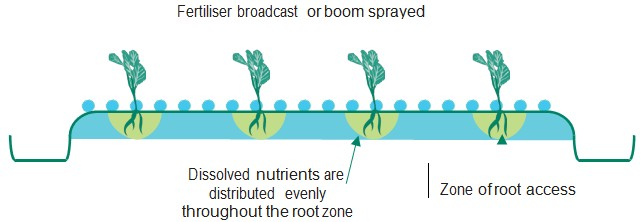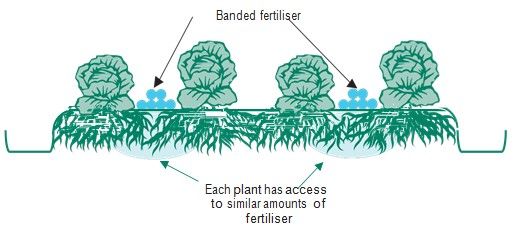Three growth phases
Phase 1: crop establishment
Good growth in the first two to four weeks of crop life is critical to crop performance. Growth achieved in this time has a major impact on final yield and the number of days from planting until harvest — one that cannot be made up in later growth phases.
To maximise crop nutrition and growth in the establishment phase, it is important to keep fertilisers in the zone where young roots are growing.
Twice-weekly broadcast or boomspray applications of fertiliser containing low rates of nitrogen during crop establishment increase yield and shorten the time to harvest. Both methods place enough fertiliser within the reach of roots to maximise crop growth without excessive loss to the environment (see Figure 2).

Applying granular NPK fertiliser to the soil surface on the day of planting is also important for achieving maximum yields, whichever fertiliser delivery method is used later.
Phase 2: rapid growth
Once the root system is established, fertilisers are most effectively applied weekly by banded application (see Figure 3).

Fertigation or broadcasting can be used in this phase. However it is difficult to apply the required rates of fertiliser with these methods without unnecessary water use or the risk of leaf burn from undissolved or lodged fertiliser granules.
Banding with compound granular fertilisers is most suitable as it minimises waste and allows the required rate of nitrogen, phosphorus and potassium to be applied in one pass.
Phase 3: maturation
After row closure, the head or other marketable part of the crop fills out, drawing accumulated nutrients from the frame developed in earlier stages, as well as from the soil. Continued application of nitrogen is usually only required if the maturation period is longer than two to three weeks.
From September to March, no further fertiliser is usually required after row closure for Iceberg and Cos lettuce. In cooler months when growth is slower, weekly fertigation with nitrogen and potassium is required up until one week before harvest.
This method of application can involve some unavoidable losses from overspray on adjacent crops, younger plantings or uncropped ground, but other methods used in earlier phases are less safe for the crop or practical in this phase.
